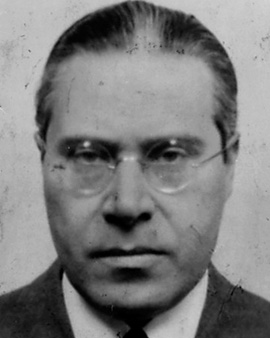The modernist László Moholy-Nagy was born in a small farming town in the south of Hungary. Fatherless, he lived with his brothers and his mother at his grandmother's house. As he later wrote as an adult, he spent this childhood in a terribly large silence. As a young man he began to study law, but this was interrupted by his entry into the army. He experienced first-hand the cruelties of the war on the Russian and Italian front. As a soldier, he discovered drawing and began to sketch intensively everything he saw and experienced, unaware that a career as an artist lay ahead of him.
Today László Moholy-Nagy is considered one of the most influential art educators in the USA of the post-war period. His curriculum as well as his own art style was influenced by Dadaism, Suprematism, Constructivism and photography. The German architect and founder of the famous Bauhaus Walter Gropius became aware of Moholy-Nagy. He granted him a teaching position at the school in Dessau. There Moholy-Nagy took over the preparatory course and taught the students a more practical, experimental and technological view of art and the art process. Throughout his life, the jack-of-all-trades was also involved in other cultural fields, from commercial design to stage design. He also made films and was art director for various magazines. His most important legacy, however, is his version of Bauhaus teaching, which he took with him to the USA. There he founded the influential Institute of Design in Chicago.
Through his interest in photography, he developed the conviction that the understanding of images by artists had to be fundamentally modernized. Moholy-Nagy's ambitious goal was to use the potential of new technologies in order to find means to satisfy the needs of mankind through experimentation. His abstract paintings show geometric shapes that appear opaque and are reminiscent of the works of Kazimir Malevich. Whether he painted, "Fotogramme″ (photographs without camera or negative) or made sculptures out of transparent plexiglass, he always examined how the basic elements light, space and time interact. As he himself revealed, he preferred to paint "not with colors, but with Licht″. In this way he combined analysis and creativity, physics and art in an impressive way.
×





.jpg)
.jpg)
.jpg)
.jpg)
.jpg)
.jpg)
.jpg)
.jpg)
.jpg)
.jpg)
.jpg)
.jpg)
.jpg)
.jpg)
.jpg)
.jpg)
.jpg)
.jpg)
.jpg)
.jpg)
.jpg)
.jpg)
.jpg)
.jpg)
.jpg)
.jpg)
.jpg)
.jpg)
.jpg)
.jpg)
.jpg)
.jpg)
.jpg)
.jpg)
.jpg)
.jpg)
.jpg)
.jpg)
.jpg)
.jpg)
.jpg)
.jpg)
_-_(MeisterDrucke-686823).jpg)
_-_(MeisterDrucke-686823).jpg)
.jpg)
.jpg)
.jpg)
.jpg)
.jpg)
.jpg)
.jpg)
.jpg)
.jpg)
.jpg)
.jpg)
.jpg)
_-_(MeisterDrucke-687519).jpg)
_-_(MeisterDrucke-687519).jpg)
.jpg)
.jpg)
.jpg)
.jpg)
.jpg)
.jpg)
.jpg)
.jpg)
.jpg)
.jpg)
_-_(MeisterDrucke-687516).jpg)
_-_(MeisterDrucke-687516).jpg)
_-_(MeisterDrucke-687513).jpg)
_-_(MeisterDrucke-687513).jpg)
.jpg)
.jpg)
.jpg)
.jpg)
.jpg)
.jpg)
.jpg)
.jpg)
.jpg)
.jpg)
.jpg)
.jpg)
.jpg)
.jpg)
.jpg)
.jpg)
.jpg)
.jpg)
.jpg)
.jpg)
_-_(MeisterDrucke-687789).jpg)
_-_(MeisterDrucke-687789).jpg)
.jpg)
.jpg)
.jpg)
.jpg)
.jpg)
.jpg)
.jpg)
.jpg)
.jpg)
.jpg)
.jpg)
.jpg)
.jpg)
.jpg)
.jpg)
.jpg)
.jpg)
.jpg)
.jpg)
.jpg)
.jpg)
.jpg)
.jpg)
.jpg)
.jpg)
.jpg)
_-_(MeisterDrucke-686833).jpg)
_-_(MeisterDrucke-686833).jpg)
.jpg)
.jpg)
_Finland_(title_on_object)_-_(MeisterDrucke-1371864).jpg)
_Finland_(title_on_object)_-_(MeisterDrucke-1371864).jpg)
.jpg)
.jpg)
.jpg)
.jpg)
_-_(MeisterDrucke-688999).jpg)
_-_(MeisterDrucke-688999).jpg)
.jpg)
.jpg)
.jpg)
.jpg)
.jpg)
.jpg)
.jpg)
.jpg)
.jpg)
.jpg)
.jpg)
.jpg)
_-_(MeisterDrucke-689108).jpg)
_-_(MeisterDrucke-689108).jpg)
.jpg)
.jpg)
.jpg)
.jpg)
.jpg)
.jpg)
.jpg)
.jpg)
.jpg)
.jpg)
.jpg)
.jpg)
.jpg)
.jpg)
.jpg)
.jpg)
.jpg)
.jpg)
.jpg)
.jpg)
.jpg)
.jpg)
.jpg)
.jpg)
.jpg)
.jpg)
.jpg)
.jpg)
.jpg)
.jpg)
.jpg)
.jpg)
.jpg)
.jpg)
.jpg)
.jpg)
_-_(MeisterDrucke-689210).jpg)
_-_(MeisterDrucke-689210).jpg)
_-_(MeisterDrucke-687883).jpg)
_-_(MeisterDrucke-687883).jpg)
.jpg)
.jpg)
_-_(MeisterDrucke-900715).jpg)
_-_(MeisterDrucke-900715).jpg)
.jpg)
.jpg)
.jpg)
.jpg)
.jpg)
.jpg)
.jpg)
.jpg)
.jpg)
.jpg)






